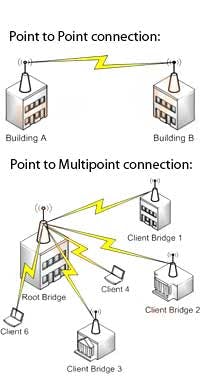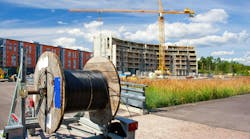So what is a wireless bridge anyway?
In simple terms a wireless bridge is a device that allows two or more complete networks of users to transparently communicate to one another over long distances without wires. These networks can be in the same building but are normally in either adjacent buildings or with the proper antennas and line of sight bridges can even connect networks up to 30 miles apart. Wireless bridges connect to the wired network through the Ethernet port and replicate that data to a remote network bridge or access point via 802.11a/b/g wireless (Wi-Fi) protocol.
Point to Point (ptp) Bridging:
A point to point topology is the simplest to configure and connects two networks in two separate locations, normally a remote building or warehouse, via one wireless bridge in each location.
Point to Multi-point (point to multipoint, ptmp) bridging:
A point to Multipoint topology wirelessly connects multiple locations together allowing them to share the same network resources. The bridge at the main, central, location is called the root bridge or base station bridge and all data passing between the wireless bridge clients must pass through the root bridge first. These point-to-multipoint networks are used in wireless internet service providers (WISP), large corporate campuses, distribution facilities, school districts, public safety applications and many others…
What do I need to build a Point to Point Bridge Link?
First, you need line of sight between the two locations. You may need to install a pole or tower on your roof top in order to achieve this. A site survey is recommended before installation.
Then you will need to select a wireless bridge. Here are some things to consider when selecting a wireless bridge.
Distance: Distance will determine what gain antenna will be required and if you need an external antenna or if an integrated antenna will be sufficient.
Wireless protocol: Do you want to use a bridge base on 802.11 standards so that you have interoperability with other bridge manufacturers or would you like something with a protocol proprietary to a particular vendor? There are some added security benefits when using a proprietary over a standard protocol.
Frequency: Do you want to use a licensed or unlicensed (2.4, 5-5.8 GHz) band?
Indoor or Outdoor: Indoor wireless bridges are less expensive but you will have to buy quite a bit of LMR-400 cable to connect to the outdoor antenna. This adds a great deal of signal loss and in the end you will need a higher gain antenna to compensate. An outdoor bridge can be placed right next to the antenna and therefore cuts down on the amount of cable you need to buy as well as the amount of signal loss.
Select a wireless antenna: If the bridge you selected does not already have an integrated antenna you will need to choose one now. For point to point links we suggest a directional panel, grid or solid parabolic dish antennas.
Peripherals: You will need to select the appropriate lightning arrestors and RF antenna cables to get you connected and protected.
Double it: Now double the amount of hardware you selected so that you have the identical setup on both sides.
Installation
Finally, select a professional installer in your area to run the appropriate cables, install any required poles or towers, align the antennas and configure the radios. If you don't currently have a relationship with a qualified installing/servicing firm, or have any questions about this process, you can contact the retailer who is selling you the equipment or potentially the equipment manufacturer, and possibly even the products distributor.
If you want to try it out yourself go for it but don't forget to bench test the bridges before actually installing them in the field.
About the author: Ronen Isaac is with Continental Computers and WLANmall.com. Continental Computers is a networking and video surveillance products reseller and integrator/VAR based out of El Segundo, Calif.


